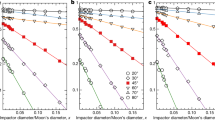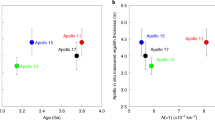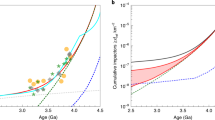Abstract
Jupiter’s large moons Ganymede1,2 and Callisto2,3 are similar in size and composition. However, Ganymede has a tectonically evolved surface1 and a large rock/metal core2, whereas Callisto’s surface shows no sign of resurfacing3 and the separation of ice and rock in its interior seems incomplete2. These differences have been difficult to explain4,5,6,7,8,9,10,11. Here we present geophysical models of impact-induced core formation to show that the Ganymede–Callisto dichotomy can be explained through differences in the energy received during a brief period of frequent planetary impacts about 700 million years after planet formation, termed the late heavy bombardment12,13,14,15. We propose that during the late heavy bombardment, impacts would have been sufficiently energetic on Ganymede to lead to a complete separation of rock and ice, but not on Callisto. In our model, a dichotomy between Ganymede and Callisto that is consistent with observations is created if the planetesimal disk that supplied the cometary impactors during the late heavy bombardment is about 5–30 times the mass of the Earth. Our findings are consistent with estimates of a disk about 20 times the mass of the Earth as used in dynamical models that recreate the present-day architecture of the outer solar system and the lunar late heavy bombardment15,16.
This is a preview of subscription content, access via your institution
Access options
Subscribe to this journal
Receive 12 print issues and online access
$259.00 per year
only $21.58 per issue
Buy this article
- Purchase on Springer Link
- Instant access to full article PDF
Prices may be subject to local taxes which are calculated during checkout


Similar content being viewed by others
References
Pappalardo, R. T. et al. Jupiter: The Planet, Satellites & Magnetosphere 363–396 (Cambridge Univ. Press, 2004).
Schubert, G., Anderson, J. D., Spohn, T. & McKinnon, W. B. Jupiter: The Planet, Satellites & Magnetosphere 281–306 (Cambridge Univ. Press, 2004).
Moore, J. M. et al. Jupiter: The Planet, Satellites & Magnetosphere 397–426 (Cambridge Univ. Press, 2004).
Schubert, G., Stevenson, D. J. & Ellsworth, K. Internal structures of the Galilean satellites. Icarus 47, 46–59 (1981).
Lunine, J. I. & Stevenson, D. J. Formation of the Galilean satellites in a gaseous nebula. Icarus 52, 14–39 (1982).
Friedson, A. J. & Stevenson, D. J. Viscosity of rock–ice mixtures and applications to the evolution of icy satellites. Icarus 56, 1–14 (1983).
Stevenson, D. J., Harris, A. W. & Lunine, J. L. Satellites 39–88 (Univ. Arizona Press, 1986).
Tittemore, W. C. Chaotic motion of Europa and Ganymede and the Ganymede–Callisto dichotomy. Science 250, 263–267 (1990).
Peale, S. J. Origin and evolution of the natural satellites. Ann. Rev. Astron. Astrophys. 37, 533–602 (1999).
Canup, R. M. & Ward, W. R. Formation of the Galilean satellites: Conditions of accretion. Astron. J. 124, 3404–3423 (2002).
Barr, A. C. & Canup, R. M. Constraints on gas giant satellite formation from the interior states of partially differentiated satellites. Icarus 198, 163–177 (2008).
Kring, D. A. & Cohen, B. A. Cataclysmic bombardment throughout the inner solar system 3.9–4.0 Ga. J. Geophys. Res. 107, 5009 (2002).
Strom, R. G., Malhotra, R., Ito, T., Yoshida, F. & Kring, D. A. The origin of planetary impactors in the inner solar system. Science 309, 1847–1850 (2005).
Levison, H. F. et al. Could the lunar ‘Late Heavy Bombardment’ have been triggered by the formation of Uranus and Neptune? Icarus 151, 286–306 (2001).
Gomes, R., Levison, H. F., Tsiganis, K. & Morbidelli, A. Origin of the cataclysmic Late Heavy Bombardment period of the terrestrial planets. Nature 435, 466–469 (2005).
Tsiganis, K., Gomes, R., Morbidelli, A. & Levison, H. F. Origin of the orbital architecture of the giant planets of the Solar System. Nature 435, 459–461 (2005).
Anderson, J. D. et al. Shape, mean radius, gravity field, and interior structure of Callisto. Icarus 153, 157–161 (2001).
Showman, A. P. & Malhotra, R. Tidal evolution into the Laplace resonance and the resurfacing of Ganymede. Icarus 127, 93–111 (1997).
Zahnle, K., Schenk, P. M. & Levison, H. F. Cratering rates in the outer solar system. Icarus 163, 263–289 (2003).
McKinnon, W. B. NOTE: Mystery of Callisto: Is it undifferentiated? Icarus 130, 540–543 (1997).
Petrenko, V. F. & Whitworth, R. W. Physics of Ice (Oxford Univ. Press, 1999).
Pierazzo, E., Vickery, A. M. & Melosh, H. J. A reevaluation of impact melt production. Icarus 127, 408–423 (1997).
Tonks, W. B. & Melosh, H. J. Core formation by giant impacts. Icarus 100, 326–346 (1992).
Tonks, W. B. & Melosh, H. J. Magma ocean formation due to giant impacts. J. Geophys. Res. 98, 5319–5333 (1993).
Reese, C. C. & Solomatov, V. S. Fluid dynamics of local martian magma oceans. Icarus 184, 102–120 (2006).
Peale, S. J. & Lee, M. H. A primordial origin of the Laplace relation among the Galilean satellites. Science 298, 593–597 (2002).
Canup, R. M. & Ward, W. R. A common mass scaling for satellite systems of gaseous planets. Nature 441, 834–839 (2006).
Morbidelli, A., Levison, H. F., Tsiganis, K. & Gomes, R. Chaotic capture of Jupiter’s Trojan asteroids in the early Solar System. Nature 435, 462–465 (2005).
Mueller, S. & McKinnon, W. B. Three-layered models of Ganymede and Callisto—Compositions, structures and aspects of evolution. Icarus 76, 437–464 (1988).
Acknowledgements
A.C.B. and R.M.C. are grateful to NASA’s Planetary Geology and Geophysics programme. We thank H. Levison, D. Nesvorný, O. Barnouin-Jha and E. Pierazzo for useful discussions, V. Mlinar and R. Citron for comments on draft manuscripts and W. B. Tonks for helpful comments.
Author information
Authors and Affiliations
Contributions
A.C.B. and R.M.C. formulated the model; A.C.B. carried out the calculations, and A.C.B. and R.M.C. jointly interpreted the results.
Corresponding author
Ethics declarations
Competing interests
The authors declare no competing financial interests.
Supplementary information
Supplementary Information
Supplementary Information (PDF 642 kb)
Supplementary Information
Supplementary Movies (GIF 623 kb)
Supplementary Information
Supplementary Movies (GIF 2092 kb)
Supplementary Information
Supplementary Movies (GIF 1652 kb)
Supplementary Information
Supplementary Movies (GIF 4537 kb)
Rights and permissions
About this article
Cite this article
Barr, A., Canup, R. Origin of the Ganymede–Callisto dichotomy by impacts during the late heavy bombardment. Nature Geosci 3, 164–167 (2010). https://doi.org/10.1038/ngeo746
Received:
Accepted:
Published:
Issue Date:
DOI: https://doi.org/10.1038/ngeo746
This article is cited by
-
Large Ocean Worlds with High-Pressure Ices
Space Science Reviews (2020)
-
Ice-Ocean Exchange Processes in the Jovian and Saturnian Satellites
Space Science Reviews (2020)
-
Heterogeneous delivery of silicate and metal to the Earth by large planetesimals
Nature Geoscience (2018)
-
Water and the Interior Structure of Terrestrial Planets and Icy Bodies
Space Science Reviews (2018)
-
Origin and Evolution of the Cometary Reservoirs
Space Science Reviews (2015)



